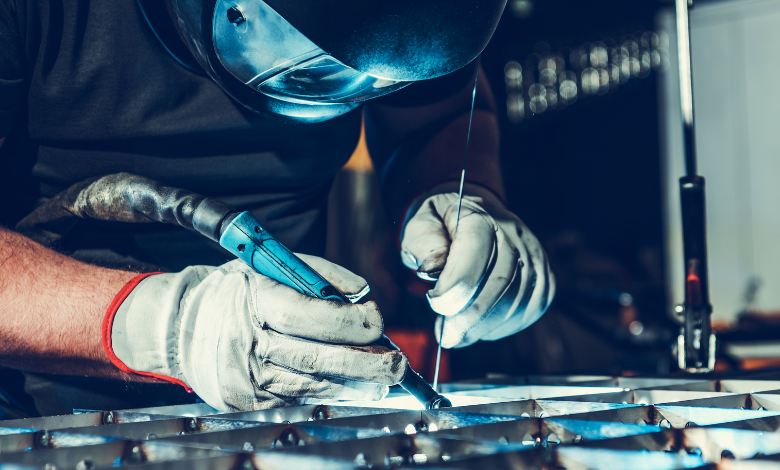Why Is Laser Welding Better Than TIG Welding

Laser and TIG welding are two precision-focused welding techniques used in various industries. However, their operations are distinct. While laser welding employs a focused laser beam for precise and efficient joints, TIG welding uses a tungsten electrode and an inert gas for high-quality welds.
This article explores why laser welding is often considered better than TIG welding. We examined various factors, such as precision, welding results, efficiency, material versatility, etc., that make laser welding the superior technique.
What is Laser Welding?
Laser welding is a high-precision welding process that uses a focused laser beam to join materials. While this welding method is unique, it follows the standard principle of metal welding. The heat generated from the laser melts the edges of the adjoining workpieces, forming a strong, seamless joint as the material cools.
This welding method offers distinct advantages, including exceptional precision, minimal distortion, and the ability to weld various materials, including plastics. Compared to traditional welding methods, it is highly efficient, enabling faster welding speeds.
In addition, laser welding provides excellent control over the weld quality, resulting in high quality and consistent results. These benefits make laser welding particularly valuable in various industries, particularly those prioritizing precision, like aerospace, automotive, and medical device manufacturing industries.
What is TIG Welding?
TIG welding, or Tungsten Inert Gas welding, is another precision welding method that uses a non-consumable tungsten electrode to produce the weld. The process is sometimes called Gas Tungsten Arc Welding (GTAW) because it involves an electric arc between the tungsten electrode and the workpiece, which melts the material to create a weld pool.
In addition, it is called an inert gas welding process because it uses an inert shielding gas, typically argon, to protect the weld area from atmospheric contamination. This helps ensure the welder creates a clean and strong joint.
While TIG welding is not as precise as laser welding, the method is renowned for its precision, particularly in comparison with other welding techniques. However, TIG welding requires the welder’s expertise, as they control the welding process. They allow the welder control over the heat input and weld bead, and if correctly done, it’ll yield high-quality welds, making it excellent for intricate and detailed works.
TIG welding is compatible with various metals, including stainless steel, aluminum, and titanium. The process also allows for welding in multiple positions and provides a cleaner weld with minimal spatter. TIG welding is widely used in industries with critical weld quality and appearance, such as aerospace, automotive, and art metalwork.
Differences Between Laser Welding vs TIG Welding
We will examine the differences between laser welding vs TIG welding under the following headings.
Precision
Regarding precision, laser welding is superior to TIG welding due to its highly focused and controllable beam. Laser welding uses a concentrated light beam that can be precisely directed, allowing for minimal heat-affected zones and highly accurate welds. This precision is crucial in applications requiring fine, detailed work, such as in the electronics and medical device industries.
While still capable of producing precise welds, TIG welding relies on the operator’s skill to control the arc and heat input. The tungsten electrode in TIG welding offers good precision, but the process can introduce more heat into the surrounding material. Therefore, there is an increased risk of welding defects, such as distortions or larger heat-affected zones, in TIG welding compared to laser welding.
Welding Results
The quality of welding results can vary significantly between laser welding and TIG welding. Laser welding produces cleaner, more aesthetically pleasing welds with minimal spatter and deformation. The high-energy laser beam creates a narrow, deep weld seam with a smooth surface finish, often requiring minimal post-processing. This makes laser welding ideal for applications where appearance and minimal finishing are essential, such as automotive and aerospace industries.
In contrast, TIG welding relies heavily on the operator’s skill to achieve consistent results. While TIG welding can produce high-quality welds, it typically makes a wider bead and is liable to more heat distortion. The process can also generate more spatter and require more post-weld cleaning and finishing.
Welding Efficiency and Speed
Efficiency is a crucial factor when comparing laser welding to TIG welding. Laser welding is highly efficient due to its rapid welding speed and minimal heat input. The focused laser beam allows quick, precise welds with minimal thermal distortion, making it ideal for high-volume production and automation. This efficiency translates to faster cycle times and lower overall production costs, especially in industries where speed and precision are crucial.
On the other hand, TIG welding is generally slower and more labor-intensive. The process requires a skilled operator to manually control the torch and filler material, leading to longer weld times and higher labor costs. Also, TIG welding requires a higher heat input, which can result in more significant thermal distortion and a need for more extensive post-weld finishing.
Material Versatility
Regarding material versatility, laser welding has a significant edge over TIG welding. Laser welding can be used on various materials, including metals, plastics, and even ceramics. This versatility makes it suitable for multiple applications across industries, such as automotive, aerospace, electronics, and medical devices. The ability to weld dissimilar materials also adds versatility, allowing for innovative and complex assemblies.
On the other hand, TIG welding is also versatile; however, it is primarily used for metals. It is especially effective for welding stainless steel, aluminum, and other non-ferrous metals. However, compared to laser welding, it is less adaptable to non-metal materials and dissimilar metal combinations.
Cost
Cost considerations are crucial in decision-making when comparing laser welding and TIG welding. Laser welding equipment typically involves higher initial costs compared to TIG welding setups. The machinery required for laser welding, including the laser source, optics, and automation systems, can be expensive to purchase and maintain. In addition, the cost of consumables such as laser gases and optics adds to the operational expenses.
In contrast, TIG welding equipment is generally more affordable and accessible. The welding machines are less costly, and the consumables, such as tungsten electrodes and shielding gas (usually argon), are relatively inexpensive. Moreover, TIG welding can be performed with basic equipment setups, making it more accessible to smaller workshops and businesses with budget constraints.
Accessibility and Ease of Use
Accessibility and ease of use are significant factors when comparing laser welding to TIG welding. Laser welding requires specialized equipment and expertise. The setup includes laser sources, optics, and precise control systems, which can be complex to operate and maintain. The need for a controlled environment to ensure beam quality adds to the setup complexity. Automated laser welding systems enhance productivity but require skilled operators to program and oversee the process.
In contrast, TIG welding is generally more accessible and easier to operate. TIG welders are widely available and are suitable for various welding tasks. The process involves a welding torch, tungsten electrode, shielding gas (typically argon), and a power source. TIG welding can be performed manually with minimal training, making it suitable for various applications, from workshops to industrial settings.
Conclusion
While laser welding and TIG welding offer significant advantages in precision welding, laser welding provides superior results. Moreover, it is the faster welding method and offers more diverse material versatility, making it ideal for high-volume production and applications requiring fine detail. However, the initial investment for laser welding is higher, so many still stick with the more common TIG welding. Understanding the strengths of each method can help manufacturers choose the best welding technique for their specific needs.



